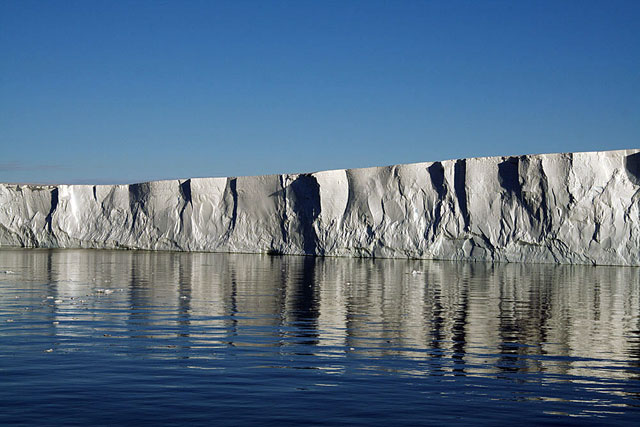|
Speeding upReport on increased melt rates at key Antarctic glacier adds urgency to 2011-12 expeditionPosted July 8, 2011
New information about increased melt rates for a key glacier in West Antarctica has added to the sense of urgency for a team headed to the Pine Island region later this year to make oceanographic measurements below an ice shelf. An international team of researchers reported last month in the journal Nature Geoscience that stronger ocean currents beneath West Antarctica’s Pine Island Glacier Ice Shelf are eroding the ice from below, which in turn is speeding the melting of the glacier that flows into it. A growing cavity beneath the ice shelf has allowed greater volumes of warm water to melt the ice, the researchers say. The glacier is currently sliding into the sea at a clip of four kilometers a year, while its ice shelf is melting at about 80 cubic kilometers a year. That’s about 50 percent faster than when the researchers visited the same region in 1994 on a previous research cruise. “More warm water from the deep ocean is entering the cavity beneath the ice shelf, and it is warmest where the ice is thickest,” said lead author Stan Jacobs In 2009, Jacobs and colleagues sailed to the Amundsen Sea aboard the research vessel Nathaniel B. Palmer The researchers found that in 15 years, melting beneath the ice shelf had risen by about 50 percent. A slight increase in ocean temperatures could not explain the high melt rate The local geology offered one explanation. On the same cruise, a group led by Adrian Jenkins The researchers believe that the ridge had once slowed the glacier like a giant retaining wall. When the receding glacier detached from the ridge, sometime before the 1970s, the warm deep water gained access to deeper parts of the glacier. Over time, the inner cavity grew, more warm deep water flowed in, more melt water flowed out, and the ice thinned. With less friction between the ice shelf and seafloor, the glacier behind it accelerated its slide into the sea. “The glaciers from the Amundsen Sea region are contributing more to sea level rise than any other part of Antarctica, so it’s imperative we understand the processes involved,” Jenkins said in a press release. Robert Bindschadler That’s why he’s leading a team of scientists on a logistically challenging expedition to the Pine Island Glacier Ice Shelf The deep-field operation, scheduled to begin in the 2011-12 field season, will require drilling a 500-meter-deep hole into the ice shelf. The team will send an instrument, a specially designed ocean profiler, down the hole to measure various ocean properties. The profiler will move vertically up and down on a cable through the entire water column to measure and monitor the complex ocean currents. [See previous articles: Pine Island Glacier and Dress rehearsal.] The expedition will take the team from McMurdo Station Emeritus scientist at NASA’s Goddard Space Flight Center “The measurement of warmer water entering in 2009 compared with 15 years earlier is unequivocal,” he said via email. “However, there are other studies that show a large temporal variability, so how typical the measurements are at any single time can be disputed, and the analysis has to be tempered by this unfortunate uncertainty. “This is exactly the uncertainty we will be addressing with sustained sub-ice measurements to begin this next season,” he added. “It is why that work is so important and why we have to begin ASAP. It strongly reinforces our work.” Both projects are partly funded by the National Science Foundation’s Office of Polar Programs Bindschadler said the effect of the subglacial ridge on the ice shelf and glacier is the leading explanation for the observed behavior. However, he said he is less certain about the larger cavity causing stronger circulation. “I have my own pending results that support their conclusion that warmer waters are more prevalent in the Amundsen Sea,” he said. “So the bottom line is I think their message is on target.” NSF-funded research in this story: Stanley Jacobs, Hartmut Hellmer and Adrian Jenkins, Columbia University, Award No. 0632282
|



For USAP Participants |
For The Public |
For Researchers and EducatorsContact UsU.S. National Science FoundationOffice of Polar Programs Geosciences Directorate 2415 Eisenhower Avenue, Suite W7100 Alexandria, VA 22314 Sign up for the NSF Office of Polar Programs newsletter and events. Feedback Form |




